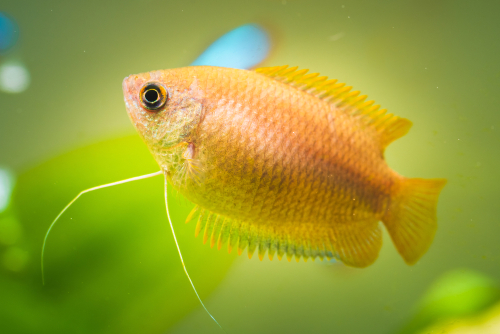Honey Gourami, otherwise known as Sunset Gourami, are a beautiful addition to any tank – but you might be looking to build up a bit more of a community than just one species. If that’s the case, then you will want to know the best Honey Gourami tank mates out there that will be safe, happy, and compatible with their needs.
That’s why we’re going to talk about what you need to be aware of before you start putting different species together and some of the top options that could become your Honey Gourami’s new best friends.
Contents
Honey Gourami Tank Mates – What You Need To Know
Putting a thriving aquarium community together is a complicated business. Even pleasing one single species can be challenging enough on its own, so when you’re adding new tank mates into the equation it should come as no surprise that you will need to know some pretty important things before you get started.
Water Parameters ; Tank Setup
First and foremost, you need to be sure that any fish that are living together will be comfortable and healthy in the same kind of water, and that your tank is set up to support all of its inhabitants.
Honey Gourami are relatively hardy compared to some other fish, but it’s still essential that you get their water requirements right. Any fish that you include with them will need to be happy in an environment with the same parameters:
- Hardness: 4 – 10 KH
- pH: 6 – 7.5
- Temperature: 72 – 82 Fahrenheit
Also, a single Honey Gourami might be comfortable in just a 10-gallon tank, but you will need to significantly increase the space for any additional individuals – even if they are also Honey Gourami.
Adult Size
One of the biggest factors that limit what kinds of species can live alongside one another is their size. Unless they are incredibly peaceful, larger fish will almost always cause problems for smaller fish – especially when you’re dealing with ones as petite as a Honey Gourami.
It is generally best to house fish that are about the same size, to avoid any kind of harassment or attempts to feed on one another. Honey Gourami grow to about 2 inches in length, so fish that are between 1 and 3 inches are ideal.
Social Temperament
As any aquarium hobbyist will tell you, each fish has a personality of their own – and that is largely dictated by the species that they are. Honey Gourami are very peaceful and non-aggressive with their tank mates, and will get along best with fish that have the same kind of temperament.
More aggressive or inquisitive fish can cause them harm or stress, so you should aim to incorporate relaxed and gentle species where possible.
Resource Competition
Even if you get two fish that are the best of friends, they both have to be able to access the individual resources they need to survive. Too many fish competing for the same food and space will mean that some get left out – which can be fatal.
While you have a reasonable amount of control over how much food you are offering, space is a more finite resource. Honey Gourami tend to swim near the top of the water, so fish that spend most of their time in the middle to lower portion of the water will provide less competition and usually feel more comfortable.
13 Best Honey Gourami Tank Mates
Now that we know the factors that are going to affect how well your new tank mates fit in with a Honey Gourami, we can look at who those tank mates might be. There are numerous options out there for small-sized non-aggressive fish that won’t spend all of their time in a Honey Gourami’s space, but some are definitely favorable over others.
We’ve taken the stress out of the situation by giving you the 13 best options that you could think about bringing home today.
Check out our other favorite posts in this category:
1. Sparkling Gourami
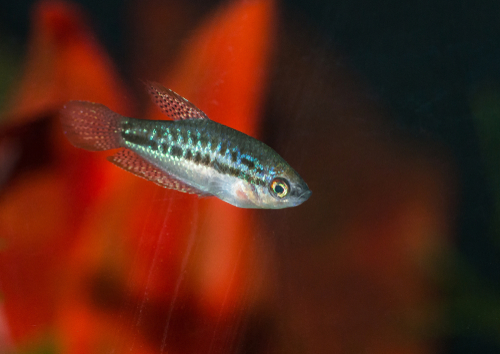
- Scientific Name: Trichopsis pumila
- Care Difficulty: Easy
- Compatibility: Small Rasboras, Ember Tetras, Small Barbs
- Full Size: 1 to 2 inches
- Origin: Southeast Asia
Honey Gourami can happily live alongside some of the other small Gourami species, and Sparkling Gourami are one of the smallest. Also known as Pygmy Gourami, these little fish are quite rare for home aquariums, but very attractive and intriguing in their own way.
They even make a sweet little chirping noise when they are happy!
Pros:
- Small size and very similar needs to Honey Gourami.
Cons:
- Slightly harder to find than more commonly found Gourami species.
2. Golden Barb
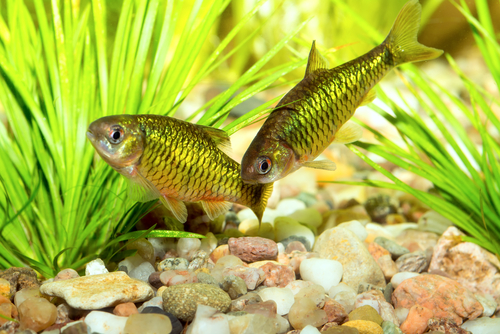
- Scientific Name: Pethia gelius
- Care Difficulty: Easy
- Compatibility: Cherry Barbs, Small Danios, Small Tetras
- Full Size: 2.5 to 3 inches
- Origin: China
Many smaller Barbs can be a good fit for living alongside Honey Gourami – the Golden Barb will certainly make for a beautiful color match though. The name for these fish could not be more accurate, because they look like they are actually carved from precious metal.
Pros:
- A beautiful appearance that suits Honey Gourami very well.
Cons:
- Like to be kept in relatively large groups of at least 6.
3. Ember Tetra
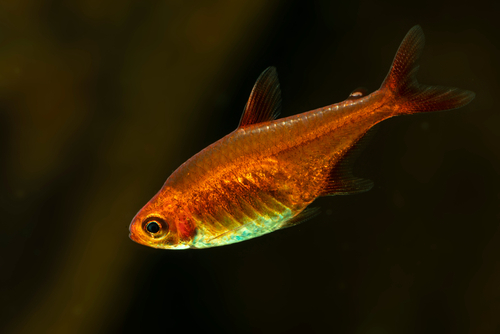
- Scientific Name: Hyphessobrycon amandae
- Care Difficulty: Easy
- Compatibility: Small Tetras, Guppies, Rasboras
- Full Size: Less than 1 inch
- Origin: Brazil
Other little Tetras would also be very happy in a Honey Gourami community (like the famous Neon Tetra), but the Ember Tetra is a slightly more interesting color variation. They may be small in size but they are blessed with heaps of personality, and are very active swimmers in the tank.
Pros:
- Fun to watch and very non-threatening.
Cons:
- Prefer a large group size and may need additional plants.
4. Guppy

- Scientific Name: Poecilia reticulata
- Care Difficulty: Easy
- Compatibility: Plecos, Tetras, Rasboras
- Full Size: 1 to 2.5 inches
- Origin: Caribbean and South America
Widely recognized as one of the best fish species for beginners to the hobby, Guppies are happy to fit into almost any freshwater tank – and they are very gentle and unassuming with their roommates as well.
They are also very beautiful, with delicate tails and all manner of different patterns and colors on their bodies.
Pros:
- Very easy to look after and the perfect size for Honey Gourami.
Cons:
- Can be vulnerable to larger fish, particularly those that exhibit fin-nipping behavior.
5. Molly
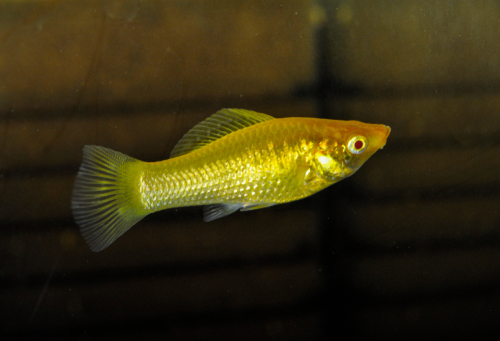
- Scientific Name: Poecilia sphenops
- Care Difficulty: Easy
- Compatibility: Loaches, Small Barbs, Zebra Danios
- Full Size: 3.5 to 4.5 inches
- Origin: Central America and South USA
The humble Molly is a very popular option for a wide variety of different community tanks. They may not always have the most vibrant appearance, but they’re incredibly easygoing and simple to care for.
Mollies also come in different color variations that you can choose from, and they are very adaptable to different environments.
Pros:
- Hardy, easy to care for, and varied in appearance.
Cons:
- Some can be slightly large and may intimidate Honey Gourami.
6. Common Platy
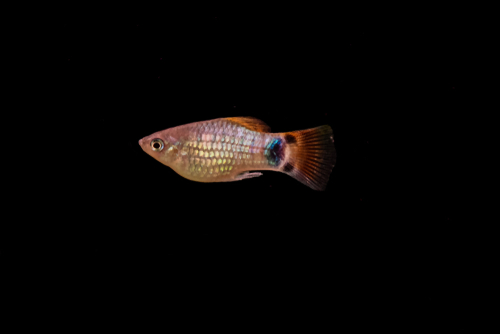
- Scientific Name: Xiphophorus maculatus
- Care Difficulty: Easy
- Compatibility: Rasboras, Plecos, Small Tetras
- Full Size: 2 to 3 inches
- Origin: Central America
Another to add to the list of aquarium icons, Platies are also very popular and a great match for a Honey Gourami tank. They are slightly smaller than Mollies in general, and they are just as peaceful and friendly to the other fish that they share a space with.
Platy fish are often crossbred, which means there are a large number of different and unique variables, with all kinds of colors and even some shape variations.
Pros:
- Peaceful, varied in appearance, and adaptable.
Cons:
- Can get a little overly friendly with tank mates and males may be aggressive toward one another.
7. Swordtail
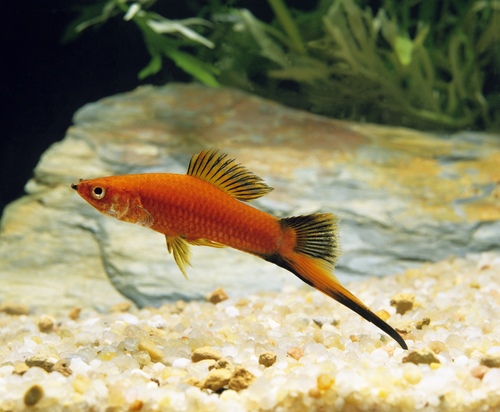
- Scientific Name: Xiphophorus hellerii
- Care Difficulty: Easy
- Compatibility: Platies, Mollies, Angelfish
- Full Size: 5 to 6.5 inches
- Origin: North and Central America
Actually quite similar in appearance to the Common Platy (enough so that they are often bred together), Swordtails are distinguished by the long, sharp tail fins that males have, which almost look like a medieval weapon.
Despite their slightly aggressive name and slightly larger size, they are incredibly peaceful and fit in very well in a variety of different community tanks.
Pros:
- Distinct and interesting appearance.
Cons:
- Slightly larger than most fish on our list, which means they do take up a bit of room and can intimidate Honey Gourami.
8. Zebra Danio
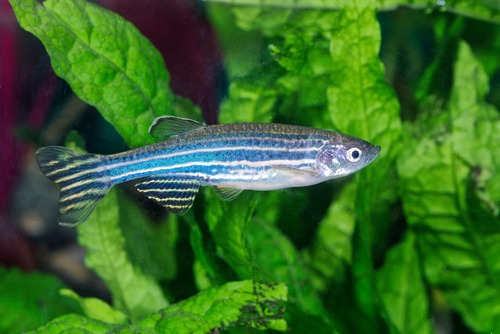
- Scientific Name: Danio rerio
- Care Difficulty: Easy
- Compatibility: Small Cichlids, Ember Tetras, Loaches
- Full Size: 1 to 2 inches
- Origin: Southern Asia
The best friend of many aquarium hobbyists, the Zebra Danio is possibly the easiest and most compatible Danio species that you can find. Though their stripes might be the first thing you notice, they have a lot of personalities to offer as well as their good looks.
Pros:
- Interesting appearance and playful personality.
Cons:
- Can become aggressive in a crowded tank.
9. Kuhli Loach

- Scientific Name: Pangio kuhlii
- Care Difficulty: Easy
- Compatibility: Small Gouramis, Tetras, and Danios
- Full Size: 3 to 4 inches
- Origin: Indonesia
If you’re after something a little bit different, Kuhli Loaches are a wonderful option. With their eel-like appearance and high-contrast striped coloring they really stand out in a tank, and they are both sociable and relaxed as well.
They also exhibit interesting behaviors to go along with their intriguing look, like burrowing under the substrate.
Pros:
- Interesting appearance and likely to spend time at the bottom of the tank, away from where your Honey Gouramis will be.
Cons:
- Can be shy and may become stressed if housed with other bottom-dwelling fish.
10. Bristlenose Pleco
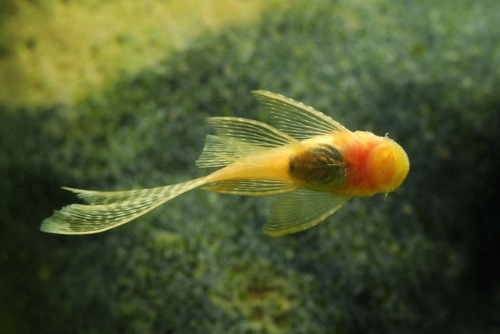
- Scientific Name: Ancistrus cirrhosus
- Care Difficulty: Easy
- Compatibility: Tetras, Cichlids, Guppies
- Full Size: 4 to 5 inches
- Origin: South America
Another tank mate with a very unique appearance, the Bristlenose Pleco is a very gentle fish. They may be a little larger than most of the species you would usually house with a Honey Gourami, but they are incredibly non-aggressive and like to keep to themselves.
Named for the bristly tentacles on their faces, these fish will spend most of their time suctioned onto something at the bottom of the tank, rather than swimming into the upper areas where your Gouramis will be.
Pros:
- Very non-aggressive with a unique appearance.
Cons:
- Not particularly active and need quite a lot of room to thrive – around 30 gallons as a minimum.
11. Otocinclus Catfish
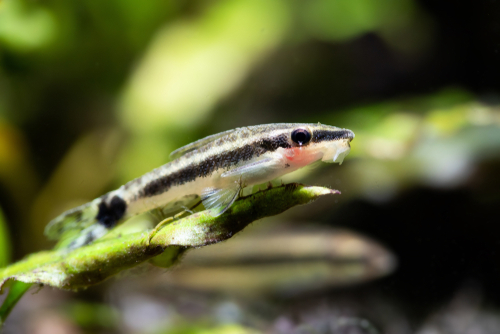
- Scientific Name: Otocinclus vestitus
- Care Difficulty: Easy
- Compatibility: Corydoras Catfish, Neon Tetras, Small Rasboras
- Full Size: 1.5 to 2 inches
- Origin: South America
Often known by the names “dwarf suckers’ ‘ or simply ‘otos’, Octocinclus Catfish are some of the best catfish species for housing in a community tank – along with the Corydoras. Some catfish can be quite aggressive, but these guys are very small and quite shy around other fish.
Pros:
- Shy, non-aggressive, and spend most of their time at the bottom of the tank.
Cons:
- Can rise up to the surface to breathe and will move around very quickly when they are swimming, which can startle Honey Gourami.
12. Harlequin Rasbora
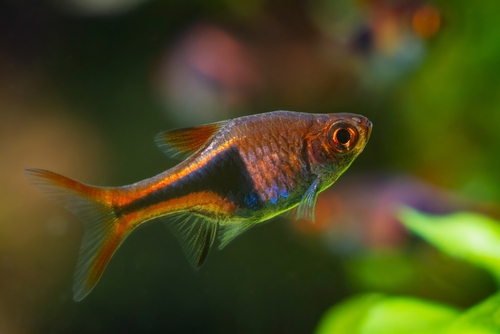
- Scientific Name: Trigonostigma heteromorpha
- Care Difficulty: Easy
- Compatibility: Small Barbs, Small Rasboras, Corydoras Catfish
- Full Size: 1.5 to 2 inches
- Origin: Southeast Asia
Harlequin Rasboras are one of the most interesting and attractive of the small Rasbora species that will get along with your Honey Gourami, and they are a perfect match in terms of their size. They’re generally pink or orange in color, and their schooling behavior is a joy to watch.
Pros:
- Entertaining in schools and an ideal size for Honey Gourami.
Cons:
- Although they are very peaceful, they do spend most of their time in the same area of the tank as Honey Gourami, so they may compete for space.
13. Amano Shrimp
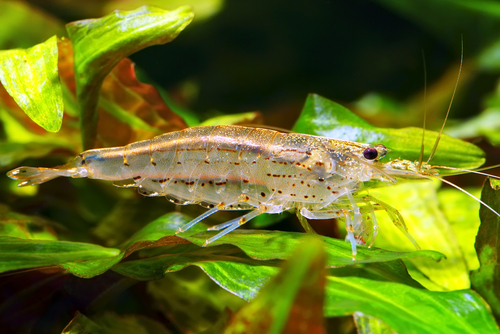
- Scientific Name: Caridina multidentata
- Care Difficulty: Easy
- Compatibility: Betta fish, Small Tetras, Small Danios
- Full Size: 1.5 to 2 inches
- Origin: Japan
If you want to avoid competition issues, then shrimp are a good alternative to traditional fish – and Amano Shrimp, in particular, are an excellent way to add variety to a Honey Gourami tank.
They are large enough to not look like food, and they will stay out of the way of your Gouramis. Amanos also have a very elegant appearance and can live for up to five years if properly cared for.
Pros:
- Easy to look after and non-competitive.
Cons:
- Very small individuals and babies can become food for almost any omnivorous or carnivorous fish.
Summary: Best Honey Gourami Tank Mates
So, who makes for the best tank mates for your Honey Gourami? Ultimately, any freshwater fish with peaceful personalities that are around the same size should be compatible, particularly if they do not spend all of their time in the upper part of the tank.
Some of the top options out there include other small Gourami, small Barbs and Tetras, or the classic Guppies, Platies, and Mollies.
Frequently Asked Questions
Is Honey Gourami a community fish?
Honey Gourami are good community fish as they are non-aggressive and do not become overly stressed in a varied tank.
How big do Honey Gourami get?
Honey Gourami rarely grow to any larger than 2 inches in length.

Ian Sterling, founder of Fishlab.com, began his aquarium journey over 30 years ago, driven by a deep fascination for fish and their diverse personalities. His website, Fishlab.com, is dedicated to making fishkeeping accessible and enjoyable, offering beginner-friendly guidance, expert insights, and a community for aquarists to connect and share experiences.


